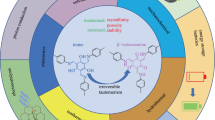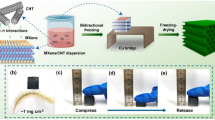Abstract
Carboxylated multiwalled carbon nanotubes (MWCNTs) were functionalized with ascorbic acid under microwave irradiation conditions as a simple and efficient method and dispersed in a chial poly(ester-imide) (PEI) matrix using solution blending technique. Optically active PEI was prepared by a step-growth polymerization of amino acid-based diacid (3) with 4,4′-thiobis (2-tert-butyl-5-methylphenol) (4) promoted by tosyl chloride in pyridine and N,N-dimethyl formamide solution. The nanocomposites (NCs) containing different loadings of functionalized MWCNTs (5, 10, 15 wt%) were produced and characterized regarding to chemical structure, morphological, and thermal properties by X-ray diffraction, FT-IR spectroscopy, thermogravimetric analysis (TGA), transmission electron microscopy (TEM), and field emission scanning electron microscopy (FE-SEM). The TGA results showed that the introduction of modified MWCNTs improved the thermal stability of NCs compared to the neat PEI. TEM and FE-SEM images of the NCs revealed that the functionalized MWCNTs were dispersed uniformly and strongly interacted with the surrounding PEI matrix. The overview of these results is presented.










Similar content being viewed by others
References
Hong J, Lee J, Hong CK, Shim SE (2010) Improvement of thermal conductivity of poly(dimethyl siloxane) using silica-coated multi-walled carbon nanotube. J Therm Anal Calorim 101:297–302
Shabanian M, Faghihi K, Raeisi A, Varvanifarahani M, Khonakdar HA, Wagenknecht U (2014) New poly(ether-imide)/MWCNT nanocomposite. J Therm Anal Calorim 117:293–299
Tahermansouri H, Biazar E (2013) Functionalization of carboxylated multi-wall carbon nanotubes with 3,5-diphenyl pyrazole and an investigation of their toxicity. New Carbon Mater 28:199–207
Sahoo NG, Rana S, Cho JW, Li L, Chan SH (2010) Polymer nanocomposites based on functionalized carbon nanotubes. Prog Polym Sci 35:837–867
Ávila-orta CA, Raudry-lópez CE, Dávila-rodríguez MV et al (2013) Morphology, thermal stability, and electrical conductivity of polymer nanocomposites of isotactic polypropylene/multi-walled carbon nanotubes. Int J Polym Mater 62:635–641
Mallakpour S, Zadehnazari A (2014) A convenient strategy to functionalize carbon nanotubes with ascorbic acid and its effect on the physical and thermomechanical properties of poly(amide–imide) composites. J Solid State Chem 211:136–145
Mallakpour S, Zadehnazari A (2013) Synthesize procedures, mechanical and thermal properties of thiazole bearing poly(amid-imide) composite thin films containing multiwalled carbon nanotubes. Colloid Polym Sci 291:1525–1534
Mallakpour S, Zadehnazari A (2013) The production of functionalized multiwall carbon nanotube/amino acid-based poly(amide–imide) composites containing a pendant dopamine moiety. Carbon 56:27–37
>Mallakpour S, Zadehnazari A (2012) Chiral poly(amide-imide)/carbon nanotube bionanocomposites containing hydroxyl pendant groups and L-phenylalanine amino acid: synthesis, preparation of thin films, and thermomechanical behavior. Soft Matter 11:494–502
Mallakpour S, Soltanian S (2014) Functionalized multi-wall carbon nanotube reinforced poly(ester-imide) bionanocomposites containing L-leucine amino acid units. J Polym Res 21:335–342
Taheri S, Nakhlband E, Nazockdast H (2013) Microstructure and multiwall carbon nanotube partitioning in polycarbonate/acrylonitrile-butadiene-styrene/multiwall carbon nanotube nanocomposites. Polym Plast Technol Eng 52:300–309
Meng L, Fu C, Lu Q (2009) Advanced technology for functionalization of carbon nanotubes. Prog Nat Sci 19:801–810
Cui LJ, Wang YB, Xiu WJ et al (2013) Effect of functionalization of multi-walled carbon nanotube on the curing behavior and mechanical property of multi-walled carbon nanotube/epoxy composites. Mater Des 49:279–284
Kathi J, Rhee KY, Lee JH (2009) Effect of chemical functionalization of multi-walled carbon nanotubes with 3-aminopropyltriethoxysilane on mechanical and morphological properties of epoxy nanocomposites. Composites A 40:800–809
Spitalsky Z, Tasis D, Papagelis K, Galiotis C (2010) Carbon nanotube–polymer composites: chemistry, processing, mechanical and electrical properties. Prog Polym Sci 35:357–401
Mahmood N, Islam M, Hameed A, Saeed S (2013) Polyamide 6/multiwalled carbon nanotubes nanocomposites with modified morphology and thermal properties. Polymers 5:1380–1391
Nakano T (2001) Optically active synthetic polymers as chiral stationary phases in HPLC. J Chromatogr A 906:205–225
Mallakpour S, Zadehnazari A (2011) Advances in synthetic optically active condensation polymers—a review. Express Polym Lett 5:142–181
Feng L, Hu J, Liu Z, Zhao F, Liu G (2007) Preparation and properties of optically active poly(N-methacryloyl L-leucine methyl ester). Polymer 48:3616–3623
Hamciuc C, Vlad-Bubulac T, Petreus O, Lisa G (2008) Synthesis and characterization of new aromatic polyesters and poly(ester-imide)s containing phosphorous cyclic bulky groups. Polym Bull 60:657–664
Mallakpour S, Zeraatpisheh F (2013) Novel chiral and organosoluble nanostructure poly(ester–imide)s containing N,N’-(3,3′,4,4′-benzophenonetetracarboxylic)-3,3′,4,4′-diimido-bis-(L-tyrosine methyl ester) as a new amino acid based diol: production, morphology, and thermal properties. Des Monomers Polym 16:488–497
Mallakpour S, Zeraatpisheh F (2011) Construction and characterization of bionanocomposites based on optically active poly(ester-imide) containing L-amino acids using nano-ZnO surface-coupled by γ-methacryloxypropyl-trimethoxysilane. Des Monomers Polym 14:487–498
Mallakpour S, Shahmohammadi MH (2004) Synthesis and characterization of novel optically active poly(imide–urethane)s derived from N,N′-(pyromellitoyl)-bis-(L-leucine) diisocyanate and aromatic diols. Polym Int 53:184–190
Mallakpour S, Soltanian S, Sabzalian MR (2011) Fabrication and in vitro degradation study of novel optically active polymers derived from amino acid containing diacids and 4,4′-thiobis (2-tert-butyl-5-methylphenol). J Polym Res 18:1679–1686
Nobile MR (2012) Carbon nanotube polymer composites. In: Nicolais L, Borzacchiello A (eds). Wiley encyclopedia of composites. New Jersey, USA pp. 1–20
Abuilaiwi FA, Laoui T, Al-Harthi M, Ateh MA (2010) Modification and functionalization of multiwalled carbon nanotube (MWCNT) via Fischer esterification. Arab J Sci Eng 35:37–48
Cruz Santos JC, Mansur AAP, Ciminelli VST, Mansur HS (2014) Nanocomposites of poly(vinyl alcohol)/functionalized-multiwall carbon nanotubes conjugated with glucose oxidase for potential application as scaffolds in skin wound healing. Int J Polym Mater 63:185–196
Van Krevelen DW, Hoftyzer PJ (1976) Properties of polymers, 3rd edn. Elsevier Scientific, New York
Acknowledgments
The authors acknowledge the Research Affairs Division Isfahan University of Technology (IUT), Isfahan, for partial financial support. Further financial support from National Elite Foundation (NEF), Iran Nanotechnology Initiative Council (INIC), and Center of Excellence in Sensors and Green Chemistry Research (IUT) is gratefully acknowledged.
Author information
Authors and Affiliations
Corresponding author
Rights and permissions
About this article
Cite this article
Mallakpour, S., Soltanian, S. Environmentally friendly functionalization of multiwalled carbon nanotube using ascorbic acid and efficient dispersion in chiral poly(ester-imide) containing 4,4′-thiobis(2-tert-butyl-5-methylphenol) moiety: thermal and morphological studies. Colloid Polym Sci 293, 1141–1149 (2015). https://doi.org/10.1007/s00396-015-3499-6
Received:
Accepted:
Published:
Issue Date:
DOI: https://doi.org/10.1007/s00396-015-3499-6




